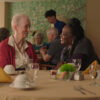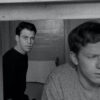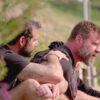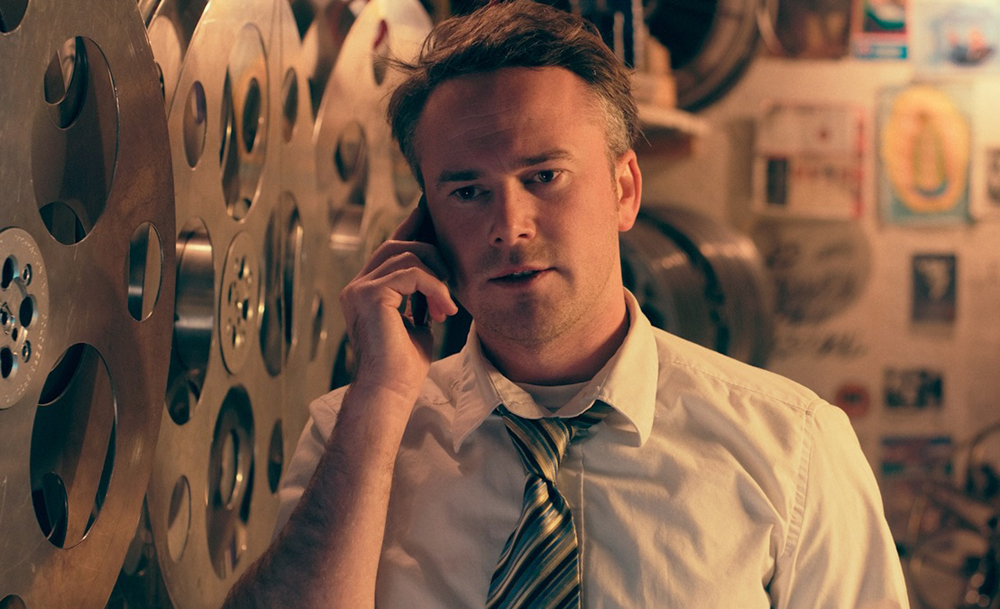Shortly after “Mountainside” begins, it’s clear from how elegantly the camera curls from the ceiling of the projection booth where posters of Cory McAbee’s “The American Astronaut,” Richard Elfman’s “Forbidden Zone” and Walter Hill’s “The Driver” serve as mementos of screenings past to the film reels that sit to the side as something’s been shown that writer/director and star Mikiech Nichols knows he’s in a hallowed space. Although the filmmaker ends up suggesting the booth was in the Admiral Theater in West Seattle where its more prominent outdoor marquee would make it easier to establish in exterior shots that his character Felix worked at a movie theater, he filmed it at the Grand Illusion Cinema, a sacred spot tucked into the University District where he really has been serving as a projectionist for the past several years.
Nichols could suspect he was onto something special in making “Mountainside,” a charming tale of a frustrated screenwriter who realizes he has to look a little more deeply inside himself to write something of meaning, prompted both by the writers’ group he begrudgingly joins and upon meeting Stella (Nicole Merat), a fellow film fan he meets at a party that he becomes deeply interested in yet can’t bring himself to ask for a phone number. It’s fitting that Felix may not be entirely aware of what progress he’s making as he starts to open himself up more to others when Nichols found himself inadvertently making cinematic history with his feature debut, committing the 55-year old Pacific Northwest theater to celluloid before it has to shift to a new location after new landlords took over the property. (A fundraiser to help with the relocation has been set up as the nonprofit plans to operate as a pop-up around the community until finding a permanent new home.)
“Mountainside” may be the first in the “Farewell to 1403” series leading up to the Grand Illusion leaving its present digs, but while it holds a specific significance from being filmed in part there, as well as other Seattle landmarks such as Scarecrow Video just down the street and Pike Place, it is one in a long line of discoveries that the theater has introduced to audiences over the years. Once a place for root canals as a dentist’s office, the 68-seat Grand Illusion has served as a slice of heaven for the adventurous moviegoer after being converted into a cozy cinema where the flowery upholstery and the purr of 35mm running through the projector provided comfort while what’s on screen pushed the envelope. In a time when repertory cinema is having a revival of its own, the Grand Illusion had a record-breaking year in 2024 and appears poised to build something even more formidable in the years to come.
Yet if you’re in the neighborhood, the theater is playing host to a number of special screenings before taking its final bow on 50th Street in February and ahead of “Mountainside” kicking off the festivities, Nichols reflected on his time at the theater, run by volunteers as a labor of love for the past 20 years, and how he was able to draw on Seattle’s vibrant filmmaking scene to put together a feature over time worth gracing its screen.
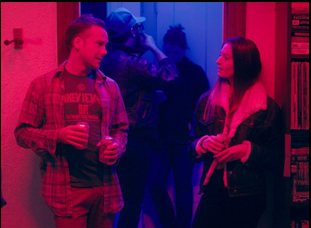
Yeah, the movie is a bit based on some experiences that I had when I had first moved to Seattle over a decade ago. I grew up in western Washington, so I would visit a lot and those touristy things were Seattle for me for a really long time. But then I’m always fascinated by going to a new city and how most of the people that live there don’t actually do the touristy things. They turn their nose up to it a little bit, but I find that tourist attractions are tourist attractions, usually for a pretty good reason. You think of some of those things like the Pike Place Market or like the Gum Wall, [which is] such a disgusting, fascinating, beautiful thing, and I wanted to make sure I was showing those things because when you watch movies based in Seattle, for the most part, you’re not really seeing Seattle. You’ll see a shot of the Space Needle, but a lot of it ends up getting filmed in like Vancouver B.C. So I wanted to make sure that not only was I showing Seattle neighborhoods, like the Seattle that the people that live there actually see, but also showcase some of those cool things, like the Gum Wall that make Seattle such a big attraction.
It seems like you give yourself a cool opportunity to make a bunch of films in one when this character has fantasies of the kinds of films he’d like to make. Was it fun to try out all those different genres yourself?
Yeah, Felix’s struggle with writing that werewolf movie was something very real to me. I had like written a bunch years and years ago, and I was like, “Man, I’m just never going to be able to make that movie.” So when I started writing this movie about an aspiring filmmaker, I [thought], “I’m going to put parts of that movie into this one.” It was really important for me because it’s such a fun visual idea, but I also [thought] I’m never going to have a budget to actually make that whole ridiculous movie.
When the story for “Mountainside” involves Felix only having a creative breakthrough on the script by getting more personal, did art imitate life in that way?
Yeah, what inspired me to start writing the movie in the first place was that I was recovering from a knee surgery. I tore my ACL and my meniscus and was staying at a friend’s house. I was all hopped up on opiates for pain, and I started getting massively depressed coming off of it, just rethinking my entire existence and all these movies and other things that I had been trying to write for so long and just not finishing anything. I’d get so caught up in having an idea that was just too hard to achieve. I started watching some other movies that were very personal films from other filmmakers and I had never written anything that personal before. I think I was always a little too scared to, but seeing other filmmakers whose work I really respected and the way they did it, it seemed like a really interesting way to explore yourself and what makes you tick. At the core, I think that’s something that’s universal for a lot of people is just standing in your own way and finding ways to overcome that. So I just started looking at the various facets of my own life and see the stories that existed within it already, rather than trying to fully fabricate something out of nothing.
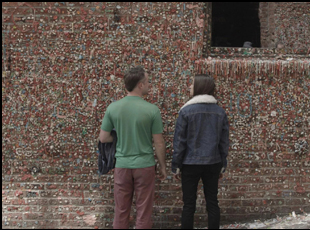
It was honestly through making “Mountainside” that I ended up getting involved in the film community and meeting so many people. I actually was not very tapped into the filmmaking scene, but into the music scene, playing in my band The Screaming Multitudes. All of my friends were musicians and I was still somewhat new to Seattle – by the time that we put the movie into production, I’d been there for about five years and I had acted in one play and done a couple little shorts with very random people, mostly just friends. But it was through acting in that play that I made some connections. One of them, Ashley Hauser, ended up popping on as the first producer of “Mountainside” and helped me get the ball rolling, but some of the other actors in it were people that I worked with in this play.
It was kind of a dream come true the way it just started coming together. I had a producer to get me started and then Chad Courtney, the director of photography, was someone who shot a music video for my friend’s band, and my band was a part of the video, so we ended up having a good rapport. I had sent him an e-mail [saying], “Hey, I’ve got this idea for a music video for The Screaming Multitudes. What do you think?” And he [said], “Yeah, I’m on board. Let’s do this.” And then probably a week later, I [said], “Hey, I actually wrote this whole feature film. How would you feel about trying to shoot it?” We had a meeting and he was totally on board and besides being a talented DP, he’s the kind of person who likes making movies with friends. He grew up in a similar way that I did, just filming stuff on weekends with your buddies, so we were able to just connect on that very fundamental level.
Naturally, the music is a really strong element of the film and there’s actually a recurring song that becomes key for the main characters’ relationship. What was that like to work on?
The music in it is something I’m really, really proud of and very thankful for. It’s all Pacific Northwest bands between Seattle and Bellingham, Washington, which is where I lived before moving to Seattle and a lot of the connections there are from being a part of the music scene here in town during that time when I was writing the movie. That song you’re talking about is called “Hey Suzzanne” by the band Posse, who I discovered when I first moved here, and I just fell in love with an EP that they had recorded. When I started writing “Mountainside,” I was listening to that song all the time and I just felt like it had to be a part of it. I was really lucky to reach out to them and get their okay to use it in the movie.
All the other music, it was the same deal – friends or bands I had played with before that I really respected. And then there’s Spine Readers, who actually ended up writing a bunch of songs for the movie, and the front person of that band who’s now passed away was one of my very good friends from growing up. He was such a talented musician, and we loved a lot of the same movies, and we’ve been supporters of each other for years and years. When I was in need of a lot of songs in post-production, I hit him up, and he [said], “Yeah, give me some references, and we’ll make music for you.” And he did it so fast and so professionally, I couldn’t be more grateful.
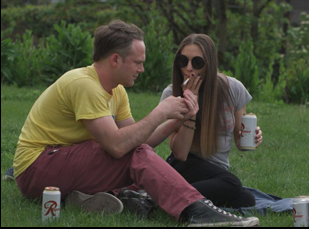
The funny thing is film is my number one passion, but I just spent so many years dabbling in it, and not pursuing it. I went to Vancouver Film School in B.C., so some of my closest friends have been working in the industry, and I’ve worked on projects with them off and on, but as far as the things that I was doing on my own, it was just so hard. I never really pursued it until this moment with “Mountainside” [where] I was getting to a point in my life where if I didn’t “make that movie,” I was going to be really upset with myself. I wrote the script off and on over the course of three-and-a-half years. I did it really slowly, and then when I finally had it done, I felt like, “Well, this seems really doable.” Little did I know I would spend the next five years of my life working on it, but it seemed really doable on paper, and I just felt like, “This is it. This is the one chance I have to actually make something.” And I was so lucky it found its footing through people coming on board that connected to the story and so ready to come back to it every couple months when we had time to film again. I’m massively proud of it now because I know what it took to make it, and I know how hard so many people worked on it to make it,
How long did the actual production last?
Principal photography took place over the course of two-and-a-half years. We started filming it in October of 2017, and we did probably the biggest part of the entire shoot with the most moving parts [including] the opening werewolf scene, we filmed that in January 2020, right before everything shut down. We would have little spurts of massively scheduled things, and then a lot of times, it was just Chad, the DP, and I trying to arrange times that worked for us, and then trying to work around of others’ schedules because it was a very small budget film, and we just leaned into whatever resources we had.
I would’ve never known it from the finished film.
I appreciate that. We definitely didn’t have a continuity person. It was mostly all me and whoever else was on set doing their due diligence to make sure we were doing the best we could continuity-wise.
This actually played at the Grand Illusion for its initial run. What was it like having your film play where you’ve been a projectionist?
It really was a dream come true because when we were filming it, I always hoped that we would be able to play it there, but I didn’t know because I’m not the one in charge of programming there, so when it actually happened, even though I made the movie, it wasn’t until being there in that moment that it hit me in such an unexpected way. Then especially doing a Q&A after the movie in that auditorium, it felt so weird in the best possible way. It was spectacular, and I think the people in the auditorium watching the movie on all three of those nights felt it, too. There was something really magical and special about it that we were all sharing together.
Another thing that was really cool about that experience, but also just the entire experience of making this movie is I never expected that from the moment I started writing it, I would be a part of every single aspect all the way through to the projection of it. When we played it at the Grand Illusion, I was still like, “I’m scooping popcorn, and I’m answering the phone, talking to people asking about the movie, whether or not it sold out.” And then I’m the one that got to press play for the very first time on our projector there, so it was wild.
That’s one step further than most filmmakers I’ve known to do it all. Were you in the discussions for this “Farewell to 1403” series, or was this just a happy surprise to be invited back?
Totally a happy surprise. I was projecting one night, and one of the programmers, who’s another projectionist there, happened to be in the booth with me, and then another volunteer came in and said to the other person in front of me, “You know, you guys should play ‘Mountainside,’ because I still haven’t seen it yet, and it’d be a fun way to send off the Grand Illusion.” And the programmer said, “I’m planning on it.” [laughs] So that was that. It was a very pleasant surprise and I was really happy to be asked back.
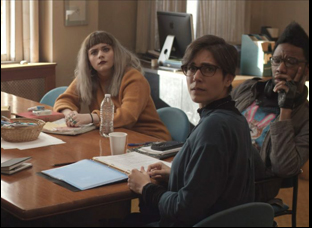
That also is so unexpected. The Grand Illusion has been operating continuously for 50 years, and up until a couple years ago, I don’t think anybody saw it disappearing. Seattle’s been changing a lot, and throughout the production, we lost locations midway through because the building got torn down. But that place has been running for so long, I just figured everything around it would disappear, but it would still stand strong. Then in the last couple years, when we started hearing that the lease was up and the building was up for sale, then people started feeling like, “Okay, it was inevitable,” but we didn’t know when it would happen. In the last year, it definitely just changed the way everybody was feeling, and now, having this movie and having the Grand Illusion in it, I’m still trying to figure out how I feel about it. I think I feel happier to have put it on camera than I even thought that I was going to feel when I did it.
I started writing the movie long before I actually started volunteering there as a projectionist, but since I was already working at the Grand Illusion, I just started realizing I don’t think I’ve ever seen this movie theater on screen before, so it became the logical next step. I would have used the exterior as well in it, but I used a different theater for the exterior, mostly just because I wanted something that looked more like a conventional movie theater out front. But the reason why I wanted to have it in the movie was because it looks cool and unique, and it was intertwined in my life at the time. I didn’t know we were going to be immortalizing something. That’s something I’m still grappling with, and I think everybody at the Grand Illusion is, but I couldn’t be more proud that we filmed there now.
“Mountainside” will screen on January 9th at the Grand Illusion Cinema at 7 pm. It is also available to stream on Prime Video, Tubi and AppleTV.
